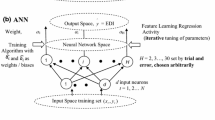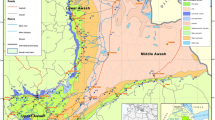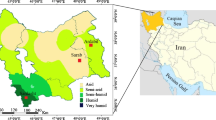Abstract
Accurate prediction of drought indices is a useful method to reduce its undesirable consequences. In this study, the workability of newly integrated hybrid forecasting approach based on Meta model and data processing methods was assessed for forecasting the Standardized Precipitation Evapotranspiration Index (SPEI) in districts with different climates. The short-, mid-, and long-term SPEIs series (i.e. timescale of 3, 9, and 24 month) were computed during the period of 1951–2019 for five sites located in Iran. In this regard, first temporal features of the SPEIs were broken down using Wavelet Transform (WT). Then, for obtaining features with higher stationary properties, Ensemble Empirical Mode Decomposition (EEMD) was applied to further decompose the obtained subseries. Finally, the most efficient subseries were selected and inserted to Meta model approaches [i.e. Feed Forward Neural Network (FFNN), Kernel Extreme Learning Machine (KELM), and Gaussian Process Regression (GPR)] as inputs. Results showed that the proposed methods enhanced the models' capability between 35 to 45%. The capability of the proposed model was verified via Overlap Discrete Wavelet Transform (MODWT) method. Results showed that the distribution range of the Root Mean Square Errors (RMSE) criteria for integrated methods decreased from 0.036–0.172 (in raw data) to 0.025–0.109 (in decomposed data). The Monte Carlo uncertainty analysis was used to assess the applied models dependability. Results showed that the integrated model with having values of 72.8% to 89.2% for the 95PPU indicator had an allowable degree of uncertainty in short- to long-tern drought modeling.









Similar content being viewed by others
Availability of Data and Material
Monthly precipitation and temperature datasets of five sites of Iran are obtained from Iranian Meteorological Organization.
References
Abbaspour KC, Yang J, Maximov I, Siber R, Bogner K, Mieleitner J, Zobrist J, Srinivasan R (2007) Modelling hydrology and water quality in the pre-alpine/alpine Thur watershed using SWAT. J Hydrol 333(2–4):413–430
Adamowski K, Prokoph A, Adamowski J (2009) Development of a new method of wavelet aided trend detection and estimation. Hydrol Process 23(18):2686–2696
AghaKouchak A, Farahmand A, Melton FS, Teixeira J, Anderson MC, Wardlow BD, Hain CR (2015) Remote sensing of drought: Progress, challenges and opportunities. Rev Geophys 53:452–480
Aussem A, Campbell J, Murtagh F (1998) Wavelet-based feature extraction and decomposition strategies for financial forecasting. J Comput Finance 6(2):5–12
Barker LJ, Hannaford J, Chiverton A, Svensson C (2016) From meteorological to hydrological drought using standardized indicators. Hydrol Earth Syst Sci 20(6):2483–2505
Cornish CR, Bretherton CS, Percival DB (2006) Maximal overlap wavelet statistical analysis with application to atmospheric turbulence. Bound-Layer Meteorol 119(2):339–374
Crausbay SD, Ramirez AR, Carter SL, Cross MS, Hall KR, Bathke DJ, Betancourt JL, Colt S, Cravens AE, Dalton MS (2017) Defining ecological drought for the twenty-first century. B Am Meteorol Soc 98:2543–2550
Dadson SJ, Lopez HP, Peng J, Vora S (2019) Hydroclimatic Extremes and Climate Change. Water Sci Pol Manage: A Global Challenge, Wiley 11–28
Ding Y, Hayes MJ, Widhalm M (2011) Measuring economic impacts of drought: a review and discussion. Disaster Prev Manag 20:434–446
Dinpashoh Y, Fakheri-Fard A, Moghaddam M, Jahanbakhsh S, Mirnia M (2004) Selection of variables for the purpose of regionalization of Iran’s precipitation climate using multivariate methods. J Hydrol 297(1–4):109–123
Farajzadeh J, Alizadeh F (2017) A hybrid linear-nonlinear approach to predict the monthly rainfall over the Urmia Lake watershed using Wavelet-SARIMAX-LSSVM conjugated model. J Hydroinform 20(1):246–262
Ghulam A, Qin Q, Teyip T, Li ZL (2007) Modified perpendicular drought index (MPDI): a real-time drought monitoring method. ISPRS J Photogramm Remote Sens 62(2):150–164
Gill MK, Asefa T, Kemblowski MW, McKee M (2006) Soil moisture prediction using support vector machines 1. J Am Water Resour Ass 42(4):1033–1046
Huang GB, Zhou H, Ding X, Zhang R (2012) Extreme learning machine for regression and multiclass classification. IEEE Transact Syst Man Cybernet Part B (Cybernetics) 42(2):513–529
Huang GB, Zhu QY, Siew CK (2006) Extreme learning machine: Theory and applications. Neurocomputing 70(1–3):489–501
Kumar P, Foufoula GE (1993) Multicomponent decomposition of spatial rainfall fields, 1. Segregation of large- and smallscale features using wavelet transforms. Water Resour Res 29(8):2515–2532
Kwak J, Kim S, Jung J, Singh VP, Lee DR, Kim HS (2016) Assessment of meteorological drought in Korea under climate change. Adv Meteorol 2016:1–13
Labate D, La Foresta F, Occhiuto G, Morabito FC, Lay-Ekuakille A, Vergallo P (2013) Empirical mode decomposition vs. wavelet decomposition for the extraction of respiratory signal from single-channel ECG: a comparison. IEEE Sens J 13(7):2666–2674
Lei Y, He Z and Zi Y (2009) Application of the EEMD method to rotor fault diagnosis of rotating machinery. Mech Syst Signal Process 23(4): 1327–1338
Li X, He B, Quan X, Liao Z, Bai X (2015) Use of the standardized precipitation evapotranspiration index (SPEI) to characterize the drying trend in southwest China from 1982–2012. Remote Sens 7(8):10917–10937
Madadgar S, Moradkhani H (2013) A Bayesian framework for probabilistic seasonal drought forecasting. J Hydrometeorol 14(6):1685–1705
Manatsa D, Mushore T, Lenouo A (2017) Improved predictability of droughts over southern Africa using the standardized precipitation evapotranspiration index and ENSO. Theor and Appl Climatol 127(1–2):259–274
Mann ME, Gleick PH (2015) Climate change and California drought in the 21st century. P Natl Acad Sci USA 112:3858–3859
Marvel K, Cook BI, Bonfils CJ, Durack PJ, Smerdon JE, Williams AP (2019) Twentieth-century hydroclimate changes consistent with human influence. Nature 569:59–65
Mishra A, Desai V, Singh V (2007) Drought forecasting using a hybrid stochastic and neural network model. J Hydrol Eng 12(6):626–638
Mukherjee S, Mishra A, Trenberth KE (2018) Climate change and drought: a perspective on drought indices. Current Climate Change Reports 4:145–163
Najafi B, Faizollahzadeh Ardabili S, Shamshirband S, Chau KW, Rabczuk T (2018) Application of ANNs, ANFIS and RSM to estimating and optimizing the parameters that affect the yield and cost of biodiesel production. Eng Appl Comput Fluid Mech 12(1):611–624
Percival DB, Walden AT (2006) Wavelet methods for time series analysis. Cambridge Univ, Press
Pham QB, Yang TC, Kuo CM, Tseng HW, Yu PS (2021) Coupling singular spectrum analysis with least square support vector machine to improve accuracy of SPI drought forecasting. Water Resour Manag 35(3):847–868
Rasmussen CE, Williams CKI (2006) Gaussian rrocesses for machine learning. MIT Press, Cambridge, MA
Rohani A, Taki M, Abdollahpour M (2018) A novel soft computing model (Gaussian process regression with K-fold cross validation) for daily and monthly solar radiation forecasting (Part: I). Renew Energy 115:411–422
Roushangar K, Ghasempour R, Biukaghazadeh S (2020) Evaluation of the parameters affecting the roughness coefficient of sewer pipes with rigid and loose boundary conditions via kernel based approaches. Int J Sediment Res 35(2):171–179
Roushangar K, Nourani V, Alizadeh F (2019) Corrigendum to a multi-scale time-space approach to analyze and categorize the precipitation fluctuation based on the wavelet transform and information theory concept. Hydrol Res 49(3):724–743
Sakizadeh M, Mohamed MM, Klammler H (2019) Trend analysis and spatial prediction of groundwater levels using time series forecasting and a novel spatio-temporal method. J Water Resour Manag 33(4):1425–1437
Salvador C, Nieto R, Linares C, Díaz J, Gimeno L (2020) Short-term effects of drought on daily mortality in Spain from 2000 to 2009. Environ Res 183:109–200
Sattar MN, Lee JY, Shin JY, Kim TW (2019) Probabilistic characteristics of drought propagation from meteorological to hydrological drought in South Korea. Water Resour Manag 33(7):2439–2452
Tayfur G (2012) Soft computing methods in water resources engineering: Artificial neural networks, fuzzy logic, and genetic algorithm. WIT Press, Southampton, UK
Tigkas D, Vangelis H, Tsakiris G (2017) An enhanced effective reconnaissance drought index for the characterisation of agricultural drought. Environ Process 4(1):137–148
Tigkas D, Vangelis H, Tsakiris G (2020) Implementing crop evapotranspiration in RDI for farm-level drought evaluation and adaptation under climate change conditions. Water Resour Manag 34(14):4329–4343
Ullah H, Akbar M (2021) Drought risk analysis for water assessment at gauged and ungauged sites in the low rainfall regions of Pakistan. Environ Process 8(1):139–162
Wang WC, Chau KW, Qiu L, Chen YB (2015) Improving forecasting accuracy of medium and long-term runoff using artificial neural network based on EEMD decomposition. Environ Res 139:46–54
Wu ZH, Huang NE (2009) Ensemble empirical mode decomposition: a noise assisted data analysis method. Adv Adapt Data Anal 1:1–41
Xiao C, Chen N, Hu C, Wang K, Gong J, Chen Z (2019) Short and mid-term sea surface temperature prediction using time-series satellite data and LSTM-AdaBoost combination approach. Remote Sens Environ 233:111358
Yu X, Liong SY, Babovic V (2004) EC-SVM approach for real-time hydrologic forecasting. J Hydroinform 6(3):209–223
Zhang Y, Li W, Chen Q, Pu X, Xiang L (2017) Multimodels for SPI drought forecasting in the north of Haihe River Basin. China Stoch Environ Res Risk Assess 31(10):2471–2481
Zhou Q, Leng G, Peng J (2018) Recent changes in the occurrences and damages of floods and droughts in the United States. Water 10(9):1109
Funding
The authors did not receive support from any organization for the submitted work.
Author information
Authors and Affiliations
Contributions
Kiyoumars Roushangar: Conceptualization, Supervision, Methodology, Review & Editing. Roghayeh Ghasempour: Project administration, Investigation, Data Curation, Methodology, Writing. Farhad Alizadeh: Formal analysis, Review & Editing.
Corresponding author
Ethics declarations
Ethics Approval
Not applicable.
Consent to Participate
Not applicable.
Consent for Publication
Not applicable.
Conflict of Interest
The authors declare no conflicts of interest/competing interests.
Additional information
Publisher's Note
Springer Nature remains neutral with regard to jurisdictional claims in published maps and institutional affiliations.
Rights and permissions
About this article
Cite this article
Roushangar, K., Ghasempour, R. & Alizadeh, F. Uncertainty Assessment of the Integrated Hybrid Data Processing Techniques for Short to Long Term Drought Forecasting in Different Climate Regions. Water Resour Manage 36, 273–296 (2022). https://doi.org/10.1007/s11269-021-03027-7
Received:
Accepted:
Published:
Issue Date:
DOI: https://doi.org/10.1007/s11269-021-03027-7




